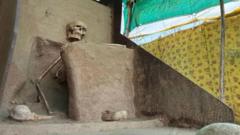Auvers-sur-Oise, an idyllic village near Paris celebrated as an artist's haven, is now the epicenter of a heated controversy following the declaration of Vincent Van Gogh's final painting, "Tree Roots." Located in the village where Van Gogh spent his last days, the roots he immortalized in his artwork have become a significant point of contention.
For years, art historians debated the chronology of Van Gogh's works due to his lack of dating. However, in a 2020 revelation, experts confirmed that "Tree Roots," capturing the gnarled roots of a black locust tree, was created on the very day of his death. This research has not only resolved the dispute about the painting's timing but has incited a new conflict between the local government and the landowners where the roots are situated.
The municipality has laid claim to a portion of this private property, asserting it is essential for public maintenance and access, especially given the newfound significance of the roots, which artist enthusiasts affectionately refer to as the "elephant." The property owners, Jean-François and Hélène Serlinger, challenged the municipality’s assertion, leading to a recent court ruling that dismissed the town's claims. Despite this legal setback, Mayor Isabelle Mézières remains adamant that the roots should belong to the community, voicing her discontent on social media, stating, “The Roots belong to the Auversois!”
As the dispute continues, the charming village, home to roughly 7,000 residents, is experiencing a shift in atmosphere. The art tourism that typically flourishes in spring has been overshadowed by this ongoing disagreement. The fate of Van Gogh's legacy in Auvers-sur-Oise hangs in the balance as the community grapples with both its artistic heritage and the complexities of modern property rights.









